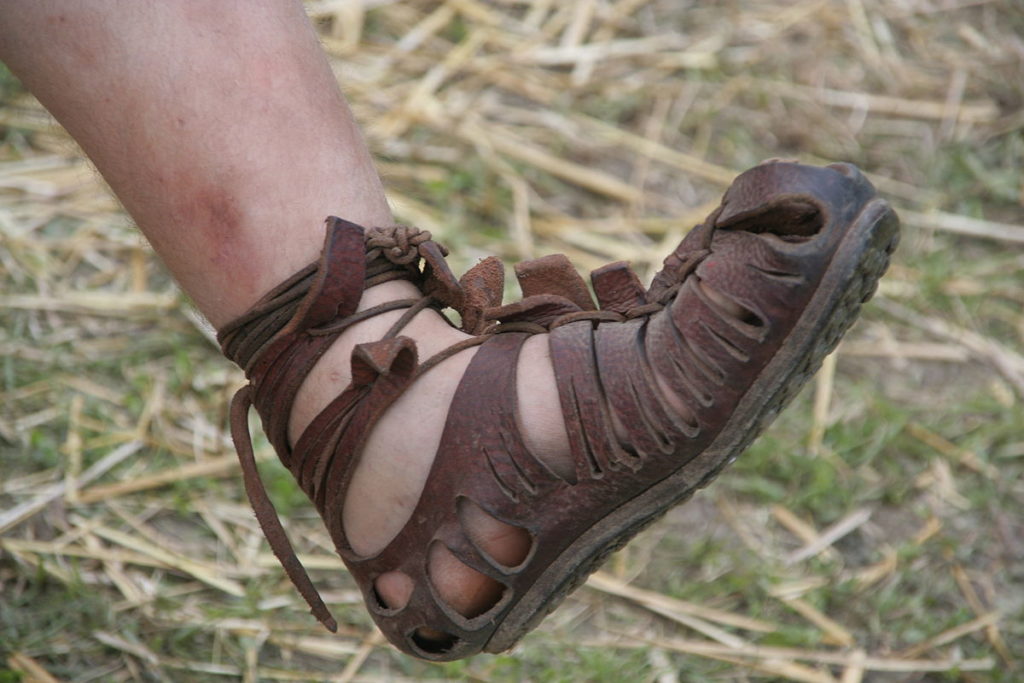[Greek] σανδάλιον (sandalion), [Latin] caliga; sandal, sole-pad, shoe with a leather or wood sole held together by thongs or straps, Mk.6:8, Act.12:8

The sandal of a Roman soldier
Background Information:
Ancient History: This term essentially means sandals or shoes. Situations and circumstances often determined the use (and non-use) of sandals. During a journey when there was no need to wear sandals, a servant (or slave) would carry the sandals of his master. Roman solders typically wore leather and thonged sandals. In Xenophon’s Anabasis IV,5,14, the men would wear their shoes so long, that their straps would sink into their flesh. Sandals were taken off in the sanctuary or for mourning (or fasting). The emperor Caligula’s “nickname” means little soldier’s boot. This comes from his father’s soldiers’ campaign in Germania.
Old Testament: This refers to the Hebrew naal, which means sandal or shoe. It was customary to walk bare foot on holy grounds. Likewise, priests also walked barefoot in the temple. No one was allowed on holy grounds with sandals or with dusty feet. Visitors, upon entering one’s house, were also required to take off their sandals. The servant (or the master) of the house would often wash their guest’s feet. This becomes an act of hospitality and service. They clothed them, put sandals on their feet, and gave them food to drink (2Chr.28:15). As David went up to the Mount of Olives, his head was covered, and he was walking barefoot (Sam.15:30). Put your sandals on your feet (Ezek.24:17). Do not come near! Remove your sandals from your feet, for where you stand is holy ground. Your clothes did not fall from you in tatters not your sandals from your feet (Deut.29:5).
New Testament: This term, meaning sandal, occurs only twice in the New Testament. However, there are also several scriptural references (in Paul’s letters) mentioning feet that provide the physical means for spreading good news and glad tidings. Like a humble servant, John the Baptist states that he is not worthy to carry the shoes or unloose the sandals of his master who comes after him. Not surprisingly, Mark, writing to a Roman audience, makes mention of sandals. Peter, upon being released from imprisonment of the Roman army, is told by the angel to put on his sandals.
Scripture:
“They were, however, to wear sandals but not a second tunic.” Mk.6:8
Jesus was telling His disciples to travel with the bare essentials.
“The angel said to him, ‘Put on your belt and your sandals.’ He did so. Then he said to him, ‘Put on your cloak and follow me.'”
The angel was getting Peter out of prison.
Conclusion:
Sandals, Caligula
It is interesting to note that in ancient history, servants (and slaves) were required to carry the sandals of their master. John, Luke, and perhaps Mark were influenced by the Hellenistic traditions. This helps to provide some context in what John the Baptist said about sandals. It was also interesting to discover the meaning (backstory) of Caligula.
It is significant to note that holy ground required clean bare feet. Washing one’s feet later becomes an important aspect of serving of others demonstrated by Jesus. Jesus illustrates the importance of serving others.
